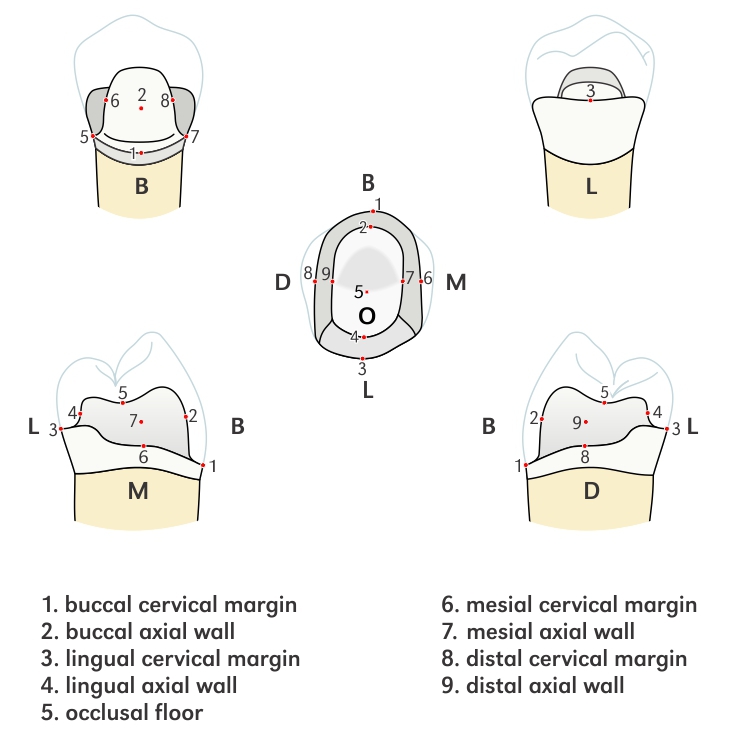IADR Abstract Archives
Marginal adaptation of ceramic and gold chamfer onlay restorations
Objectives: Marginal adaptation of ceramic onlays were compared to cast gold onlays.
Methods: An occlusal coverage onlay (1-mm buccal-cervical chamfer/1.5-mm occlusal-reduction/lingual chamfer) preparation was designed on a mandibular premolar ivorine tooth. CerecStoneBC® dies (n=16) from polyvinylsiloxane impressions were made. Gold alloy(G)-(n=8) onlays were fabricated using 3-Shape®, a Projet®3500-3D printer and cast using the lost-wax technique. IPS-e.max®CAD(E)-(n=8) onlays were fabricated using Cerec® 4.3/CEREC-AC®, Omnicam® and MCX® milling machine set to similar parameters. The onlays were cemented (250g force) on a master stone die with a dual-cure resin cement, embedded in epoxy resin, and sectioned to provide 4-external margin and 5-internal margin locations. [(BC)-buccocervical, (MC)-mesiocervical, (DC)-distocervical, (LC)-linguocervical, (BA)-buccoaxial, (MA)-mesioaxial, (DA)-distoaxial, (LA)-linguoaxial, and (O)-occlusal]. Cement gaps were measured with a Nikon Measurescope™ at 100x with interface software.
Results: Marginal gap measurements are provided in Table 1. Two-way ANOVA revealed significant interactions (p≤0.05) for the terms; margin location, margin location/material, and material. Tukey-Kramer post-hoc comparisons identified significant differences (p≤0.05). External margins for G-(MC), G-(DC) and G-(LC) showed significantly lower mean marginal gaps than the respective margin location for E. Internal gaps for both (G) and (E) materials were not significantly different except for (O) which was larger for the (E) material. With a few exceptions, the mean marginal gaps for both materials (E) and (G) exceeded the parameters of 50µm external margin adhesive gap and 60µm internal spacer gap after cementation. CV (S.D./mean) was similar for both materials (G)-39% and (E)-40%.
Conclusions: The internal marginal adaptation was more consistent between the two materials than the external marginal adaptation. External margin adaptation was significantly better at three out of four margin locations for the gold onlays. The (O) internal gap was substantially larger than the programmed parameter of 60µm for both G and E materials. CV values indicate similar variability for both materials.
Methods: An occlusal coverage onlay (1-mm buccal-cervical chamfer/1.5-mm occlusal-reduction/lingual chamfer) preparation was designed on a mandibular premolar ivorine tooth. CerecStoneBC® dies (n=16) from polyvinylsiloxane impressions were made. Gold alloy(G)-(n=8) onlays were fabricated using 3-Shape®, a Projet®3500-3D printer and cast using the lost-wax technique. IPS-e.max®CAD(E)-(n=8) onlays were fabricated using Cerec® 4.3/CEREC-AC®, Omnicam® and MCX® milling machine set to similar parameters. The onlays were cemented (250g force) on a master stone die with a dual-cure resin cement, embedded in epoxy resin, and sectioned to provide 4-external margin and 5-internal margin locations. [(BC)-buccocervical, (MC)-mesiocervical, (DC)-distocervical, (LC)-linguocervical, (BA)-buccoaxial, (MA)-mesioaxial, (DA)-distoaxial, (LA)-linguoaxial, and (O)-occlusal]. Cement gaps were measured with a Nikon Measurescope™ at 100x with interface software.
Results: Marginal gap measurements are provided in Table 1. Two-way ANOVA revealed significant interactions (p≤0.05) for the terms; margin location, margin location/material, and material. Tukey-Kramer post-hoc comparisons identified significant differences (p≤0.05). External margins for G-(MC), G-(DC) and G-(LC) showed significantly lower mean marginal gaps than the respective margin location for E. Internal gaps for both (G) and (E) materials were not significantly different except for (O) which was larger for the (E) material. With a few exceptions, the mean marginal gaps for both materials (E) and (G) exceeded the parameters of 50µm external margin adhesive gap and 60µm internal spacer gap after cementation. CV (S.D./mean) was similar for both materials (G)-39% and (E)-40%.
Conclusions: The internal marginal adaptation was more consistent between the two materials than the external marginal adaptation. External margin adaptation was significantly better at three out of four margin locations for the gold onlays. The (O) internal gap was substantially larger than the programmed parameter of 60µm for both G and E materials. CV values indicate similar variability for both materials.

